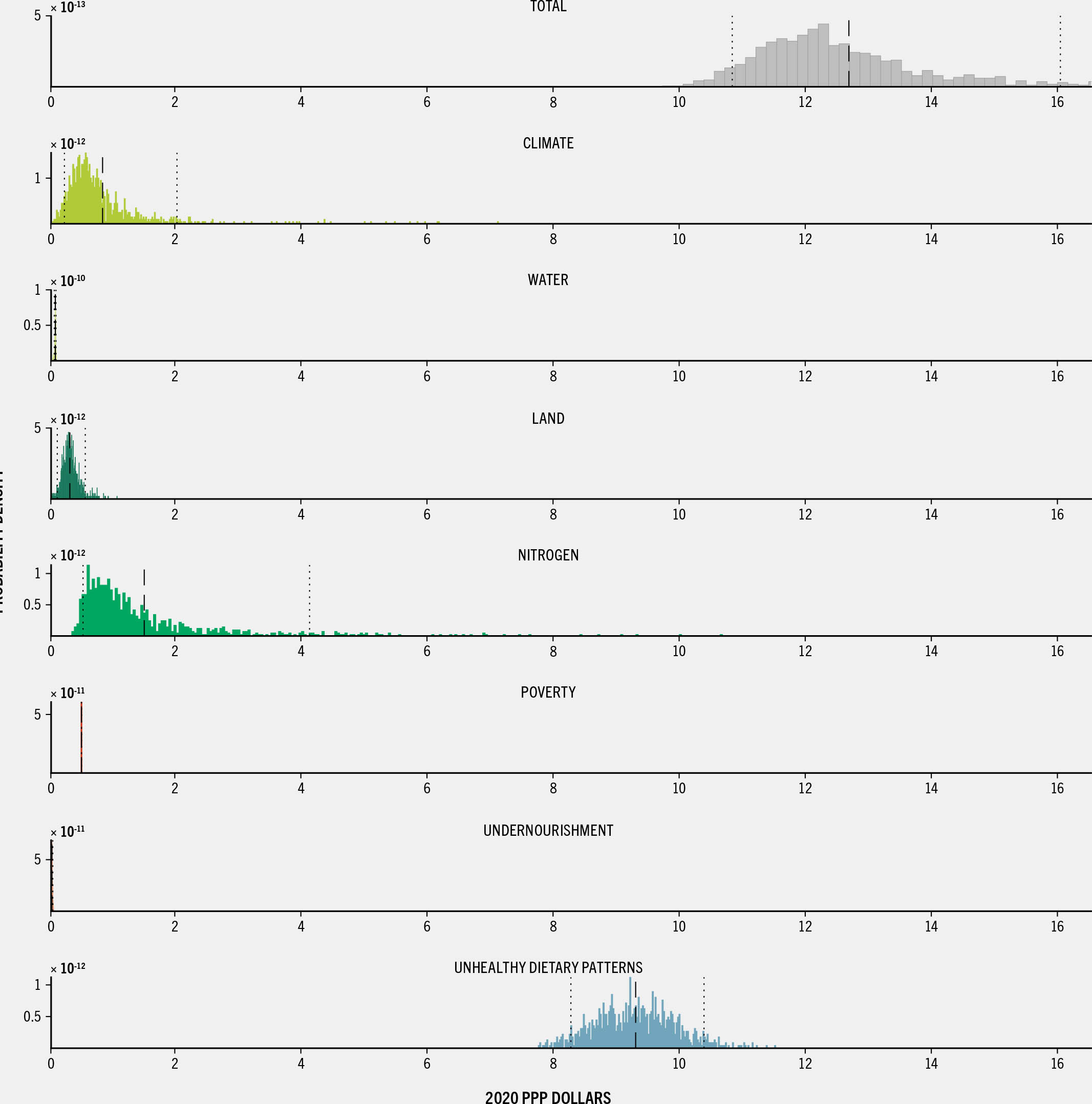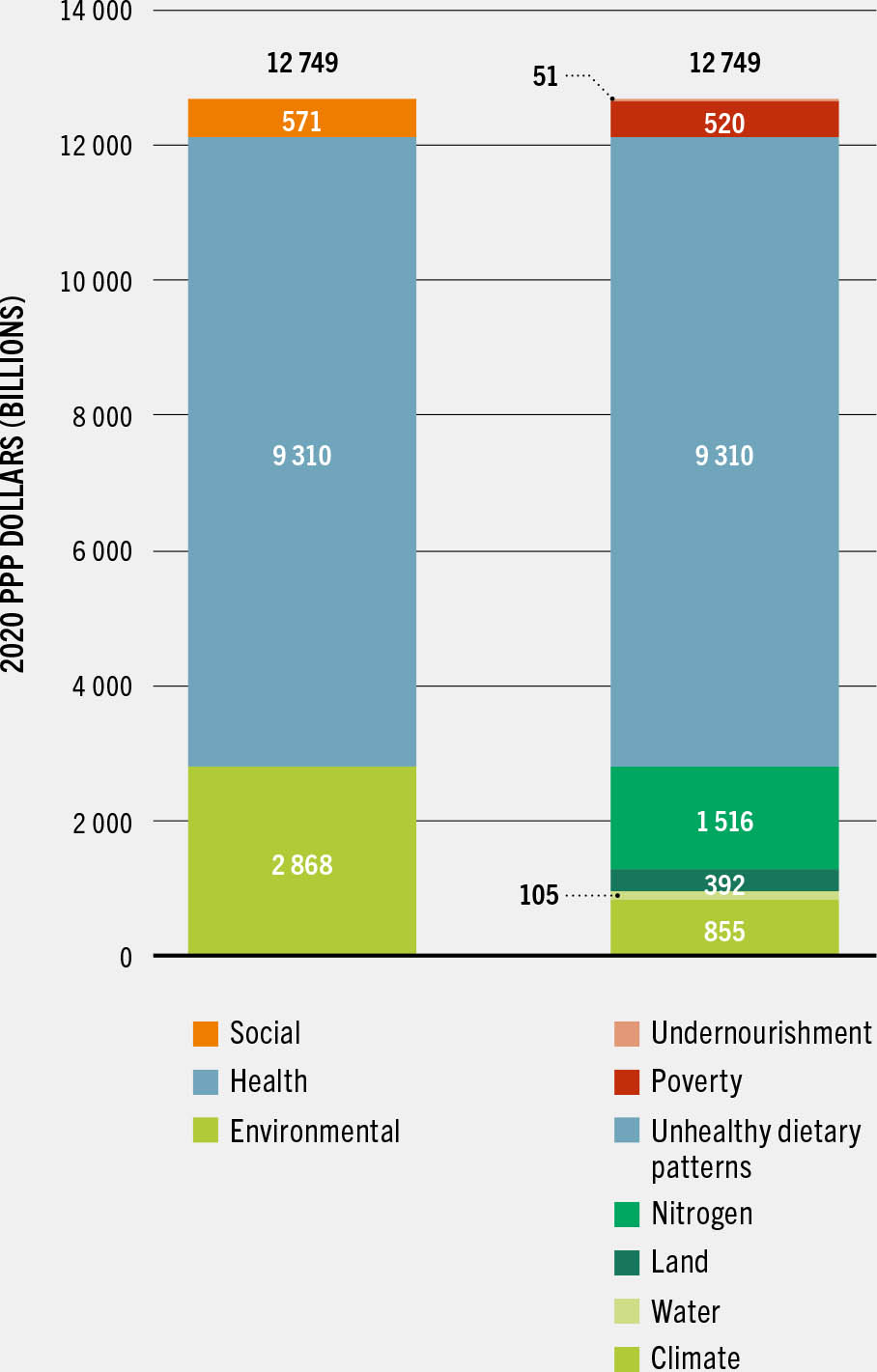This report estimates the expected value of the global hidden costs of agrifood systems in 2020 – from GHG and nitrogen emissions, water use, land-use change, unhealthy dietary patterns, undernourishment and poverty – at 12.7 trillion 2020 PPP dollars. This value is almost 10 percent of global GDP PPP in 2020. Per day, these costs are equivalent to 35 billion 2020 PPP dollars. As likewise evidenced by previous analyses,l these results point to the alarming environmental, social and health consequences our agrifood systems impose on society and call for urgent transformation towards sustainability across all dimensions.
An attractive feature of the TCA analysis underpinning the results presented here is that it allows for confidence intervals that reflect the uncertainty of the hidden costs of agrifood systems. These estimates use probability distributions to take into account the large uncertainty in cost calculations; this uncertainty results not only from a lack of data on various hidden costs (such as the impact on ecosystem services), but also from incomplete data from some countries and regions. Therefore, the estimates can be presented as ranges rather than point estimates to reflect this uncertainty. When accounting for this uncertainty, it is estimated that global hidden costs have a 95 percent chance of being 10.8 trillion 2020 PPP dollars or higher, and a 5 percent chance of being 16 trillion 2020 PPP dollars or higher (see Box 7 for more details).1 Yet, even the lower bound of 10.8 trillion 2020 PPP dollars reveals the undeniable urgency of agrifood systems transformation for minimizing the sizeable challenge faced by the planet and its population. In other words, uncertainty should not be used as a reason to postpone action.
Box 7Uncertainty in the global estimates of the hidden costs of agrifood systems
Shedding light on and acknowledging uncertainty is a key step in decision-making, as it allows the identification of appropriate strategies that perform well over a wide range of conditions faced now and potentially in the future. Costing the hidden impacts of agrifood systems involves a large degree of uncertainty, made clear in this report by the large spread of the estimates: hidden costs range between 10 trillion and 16 trillion 2020 PPP dollars, or potentially higher, with 12.7 trillion 2020 PPP dollars the expected outcome. Looking at the individual cost categories allows us to break down the uncertainty and understand for which impacts of agrifood systems the data constraints are more severe. The figure illustrates the contribution of each cost category to total quantified hidden costs, as well as the inherent uncertainty as a probability distribution. The top probability distribution combines all quantified hidden costs.
Costs associated with nitrogen emissions and unhealthy dietary patterns have the highest expected values, followed by greenhouse gas (GHG) emissions and land-use change costs. However, nitrogen costs have the highest uncertainty, as illustrated by the long green tail. This is due to the lack of knowledge concerning the value of ecosystem services, the absence of spatially explicit data on the damage to ecosystem productivity from nitrogen loading, and the compounding uncertainty along the nitrogen cascade. Overall, the transfer of ecosystem service marginal values using national-level statistics, despite using the most extensive selection of studies available, results in high uncertainty in extrapolating values to ecosystem services in other countries.22 As a result, the expected value of the hidden costs of nitrogen emissions are higher than the expected costs associated with GHG emissions, although, in reality, the economic effects are probably of the same magnitude, as the two probability distributions are quite similar, except for the long nitrogen tail.
The range of estimates is also robust to the uncertainty inherent in hidden costs coming from interactions between environmental, social and health hidden costs (for a sensitivity analysis, see Lord [2023]).1
FIGURE Global quantified hidden costs of agrifood systems, with uncertainty, by cost category, 2020

SOURCE: Lord, S. 2023. Hidden costs of agrifood systems and recent trends from 2016 to 2023 – Background paper for The State of Food and Agriculture 2023. FAO Agricultural Development Economics Technical Study, No. 31. Rome, FAO.
Figure 6 breaks down the quantified hidden costs associated with agrifood systems by cost category (left) and subcategory (right). Out of the total 12.7 trillion 2020 PPP dollars in quantified hidden costs in 2020, more than 9 trillion 2020 PPP dollars (or 73 percent) were due to health-related costs from dietary pattern-induced productivity losses. Environmental costs, which are likely underestimated, have an expected value of nearly 2.9 trillion 2020 PPP dollars, corresponding to about 20 percent of total quantified hidden costs caused by agrifood systems. Of these, more than half pertained to nitrogen emissions (mostly from runoff to surface waters and ammonia emissions to air), in part due to the large degree of uncertainty (see Box 7). These were followed by the contributions of GHG emissions to climate change (30 percent), land-use change costs (14 percent) and water use (4 percent). Social hidden costs associated with poverty and undernourishment were smaller, accounting for just 4 percent of total quantified hidden costs, mostly driven by moderate poverty in the agrifood sector.
FIGURE 6 Quantified hidden costs of agrifood systems by cost category (left) and subcategory (right), 2020

SOURCE: Lord, S. 2023. Hidden costs of agrifood systems and recent trends from 2016 to 2023 – Background paper for The State of Food and Agriculture 2023. FAO Agricultural Development Economics Technical Study, No. 31. Rome, FAO.
The finding that unhealthy dietary patterns leading to obesity and NDCs are the main contributor to global hidden costs may be surprising to many, especially given the historical emphasis of the impact of agrifood systems on the natural environment. This finding should not, however, steer attention away from the environmental consequences of agriculture and food production. Rather, it emphasizes the importance of repurposing current public support for food and agriculture and current food environments towards the production of nutritious and diverse foods that go to make up healthy diets and, in parallel, empower consumers to choose these diets with complementing agrifood systems policies.10 The urgency of promoting these diets is further justified by the positive impacts they will have not only on consumers’ health, but also on the environment. Past evidence has shown that the adoption of healthier and more sustainable dietary patterns reduces costs related to climate change by up to 76 percent.19 Furthermore, were health and environmental costs to be included in the cost of diets, healthier and more sustainable dietary patterns would have lower wholesale costs, on average, than current diets. In other words, a fuller cost accounting increases the cost of current (unhealthy) dietary patterns, but also makes healthier and more sustainable dietary patterns relatively more affordable.19


